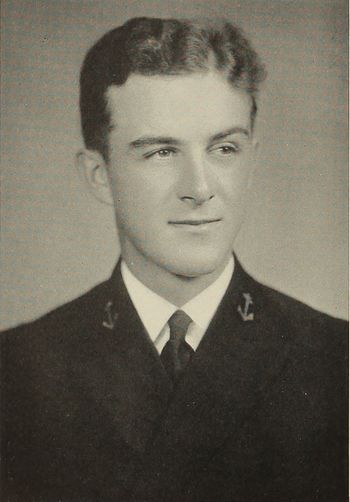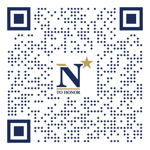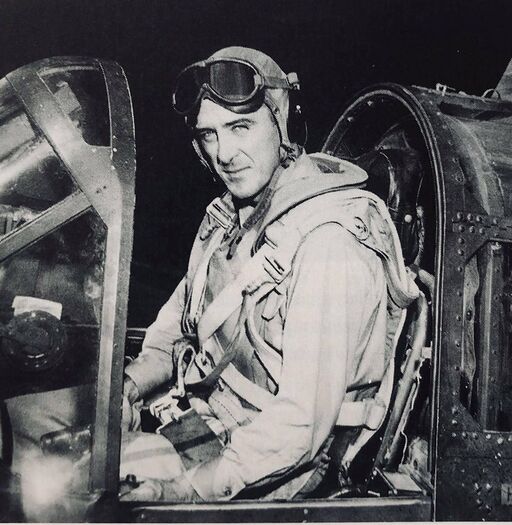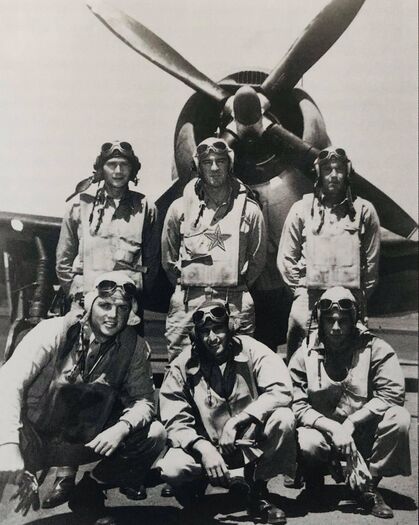RICHARD MCGOWAN, CDR, USN
Richard McGowan '35
Lucky Bag
From the 1935 Lucky Bag:
RICHARD McGOWAN
Alexandria, Virginia
"Dick" "Mac"
THIS is our Cavalier, Richard, from the land of Mint Juleps and Auld Lange Syne. A true Southern gentleman, he is often inclined to the horizontal, possibly to save himself for the whirlwind finish he usually makes at the end of a term. When the horizon seems darkest, however, and the identification of stars is almost impossible, his tenacity of purpose is a revelation; a natural borrower, he has been the increasing delight of his roommates, but his generosity more than makes up for this. Athletically, baseball has been his forte, although he is fond of wrestling. Genial, likeable, the possessor of many social graces, and a natural knack for forming friendships, have made knowing him, a constant source of pleasure.
Baseball 4, 3, 2, 1, N*. 1 P.O.

RICHARD McGOWAN
Alexandria, Virginia
"Dick" "Mac"
THIS is our Cavalier, Richard, from the land of Mint Juleps and Auld Lange Syne. A true Southern gentleman, he is often inclined to the horizontal, possibly to save himself for the whirlwind finish he usually makes at the end of a term. When the horizon seems darkest, however, and the identification of stars is almost impossible, his tenacity of purpose is a revelation; a natural borrower, he has been the increasing delight of his roommates, but his generosity more than makes up for this. Athletically, baseball has been his forte, although he is fond of wrestling. Genial, likeable, the possessor of many social graces, and a natural knack for forming friendships, have made knowing him, a constant source of pleasure.
Baseball 4, 3, 2, 1, N*. 1 P.O.
Loss
Richard was lost when his Curtiss SB2C-3 Helldiver was crashed on October 24, 1944 during the Battle of Leyte Gulf. He had been commanding officer of Bombing Squadron (VB) 19 since that squadron's formation in August 1943.
Other Information
From "The Voices of Bombing Nineteen":
The first impression of VB-19 wouldn't be complete without a little previous background. After finishing cadet training, followed by instructor training, I went to instructor duty. We instructed in every phase of flight training. Every department head was a Naval Academy graduate. We had to walk a more narrow line than a cadet. Discipline, regulations and performance were stringent.
When I came to Squadron 19 I couldn't believe I was in the same navy -- the pomp and starch were gone. The facilities, including the skipper's office, were one big eyesore. There was no order, and everything seemed to be going in all directions. The dress code was shocking; however, everyone was quite friendly and helpful. This ole boy had to make some fast adjustments. The airmanship and airdiscipline made one's hair stand up. Tactics were appalling. After hearing lecture after lecture from such as Butch O'Hare, Thatch, and others on the latest fleet, here we were years behind.
Somehow things started coming together. The wild ass carefree Ensigns showed they could and did produce. Later I found this to be the best all around group that I have ever been associated with.
The mix of experience and inexperience in the squadron became a problem for our Skipper. Besides himself and three others there was no combat experience in the squadron. The Ensigns coming from operational training were the best trained dive bombers because of their recent intensive training. The remainder of the squadron pilots were former instructors who had finally "escaped" to fleet duty. Our radiomen gunners, except for one second class radioman who flew with the CO, came as recent graduates of the fleet gunnery school.
The Skipper took "Baby" Wodell and me in his jeep to go up to the top of Haleakala Volcano. "Baby" was in the back seat. We wore our guns because the Skipper was sure there were hostile Japs on the Island. As we drove up the incline, a flock of pheasants ran out in front and along the side of the jeep. "Baby" whipped out his pistol and started shooting. The Skipper whipped the jeep off the road looking for cover and nearly turned the jeep over. "Baby" kept shooting. When the jeep came to rest, Skipper yelled at "Baby", "What the hell are you shooting at?" "Baby" said, "Birds, and I think I got one." Skipper yelled, "You damn fool, you nearly got us killed. Besides, it's against the law to shoot those birds." We never made it to the top of Haleakala, and "Baby" and I weren't asked to ride with the Skipper again.
Richard McGowan nailed me on three occasions for a total of thirty days in hack. Although I cautiously derided him as an "academy boy", I had a deep respect for his values. Many of his decisions regarding my behavior (one involving my life) filled me with admiration for his canny assessments. I suspect his sense of justice would have been sorely tested had he known Bill Good and I broke into the food locker on Maui and (to quote one of McGowan's memorable expressions) "caused considerable consternation" on the island.
Then there was the night after a few hours of "attitude adjustment" time at the O-Club on Maui that John Butts, being a senior type LT, suggested strongly to lowly Ensign Emerson that we escort two lovely Army nurses that he had cut out of the mob at the club that night, back to their quarters somewhere up the side of Haleakala.
Seemed like the only decent thing to do as well mannered Naval Officers, besides, who was I to argue with a senior LT. Our major problem in this operation, of course, was "wheels". John, as I prefer to recall, took care of that minor item by finding a very convenient jeep outside the club with a combat switch instead of a key.
Somehow I wound up driving, with my escortee sitting in a separate seat (jeep style). Poor John was forced to sit so close to his companion, in the rear seat, that they actually had to hold on to each other during the entire ride! John didn't complain a bit. This impromptu operation was going swimmingly well, until just before arriving at the mountainside quarters of the nurses, my lady happened to ask what the letters on the lower right side of the windshield meant. The letters carefully stenciled there were C.O. VB-19.
From that point on, John seemed to be preoccupied with some deep thoughts that, strangely enough, did NOT include the young lady that he had been forced to hang onto during the ride. This was particularly true after one of our female companions recalled that one of her friends had a scheduled date with the Commanding Officer of the Bombing Squadron from NASKA. That friend had also commented that her date had his own "wheels" and didn't have to be worried about transportation when he would bring her back to these mountainside nurses quarters.
If my memory serves me correctly, we did not linger long after taking the ladies home. We proceeded at "buster" plus "gate" power settings (Senior Officer Present LT John Butts now driving) to the BOQ at NASKA.
My short one-sided conversation with the Skipper the next morning was merely to confirm what he already knew. It seems to me that I was summarily dismissed from the inquisition with some comment about "damn Reserve Ensigns", etc., etc. John's conversation with the old man was much longer, and John's reluctance to discuss it anymore left me with the distinct impression that it was decidedly one-sided!
I was LT Butts's radioman-gunner, and we flew on the port wing position of CDR McGowan.
On 24 Oct. 1944 the Skipper's division, 12 SB2C-3's, was launched to find and attack a Jap Battle Force somewhere in the Philippine Islands. All the aircraft were equipped with dropable wing tanks. To my knowledge, we had never used these drop tanks before, but, because the location of the Japs was vague, the planners must have figured we needed the extra gas.
We headed for the middle of the islands and on the way encountered some real bad weather. McGowan decided he could get over the clouds and up we went. I got so cold in the back of that SB2C that I used the Addis Lamp as a heat lamp to keep my feet warm. Anyway, McGowan decided we couldn't get over the clouds and started a real steep descent. After a few minutes the speed really built up and the wing tanks started being ripped off the bomb racks. What happened next was really wild, and being in the first section and facing backwards, I really had a good view of gas tanks being ripped off and free falling through a close formation of SB2C's. It was a miracle nobody was hit.
We finally got through the weather and were about to find the Jap force when McGowan had electrical problems. LT Scott, his other wingman, was to escort him back to the Lex, and Butts was told to join up with the tail end of the division, which would make us the last aircraft to dive bomb the Jap force. Lochner
24 October - When launched, our Division, led by Commander McGowan, headed for the San Bernardino Strait to hit the Jap fleet. The group was made up of VB, VF, and VT. Just before reaching the target area, the Skipper's plane developed problems which I believe to have been electrical. The Skipper was directed to return to the fleet, and I was assigned to take him back. Shortly after we broke away for the formation, I received a call from Jancar saying that he was having problems and requesting to return to the ship with the Skipper and me. He joined up on us. At the time we were letting down through the weather and were over what I believed to be the San Bernardino Strait. The Skipper's plane had problems maintaining a low air speed, while Jancar's, with whatever his problem was, had difficulty maintaining a fast cruising speed. Whatever our problems, we leveled out at about 500 feet with the ceiling at about 800 feet. At this point we had mountains on both sides of us, with their tops obscured by the low ceiling. I estimated that we were in the straits and proceeded down the channel which I assumed would lead to open sea. At about that time I spotted a single Jap fighter at two o'clock and slightly above us. I turned our crippled group into him for a gunnery run. Fortunately he ran. We continued on at 110 knots, came out into open sea and proceeded on a course back to the task group. The weather continued to be very bad and when I thought we were near the Lex, I called and asked for permission to come aboard. The return reply was negative, orbit where you are, the ship is under attack. After circling for about ten minutes, I called again and got no answer. I then decided to go on in. As we approached the Lex, I received clearance to come aboard. Jancar went aboard first with the Skipper going next on a very long straight approach. Just before he reached the ship, his plane crashed into the sea. I flew over him and saw that he and his gunner were in the water. I came around again and dropped a smoke flare, then landed aboard. Admiral Mitscher called me up to flag plot and asked me what I had seen. After I reported what had happened, he thanked me and let me get back to the Ready Room, where I learned that the Skipper had been lost and that his gunner, E.A. Brown, had been picked up. Scott
It is difficult to understand just what happened to Dick McGowan that day. I personally know he was a very fine athlete. He beat my butt enough times at handball at Los Alamitos that I finally gave up playing him. Bill Emerson
His wife was listed as next of kin. He has a memory marker in Virginia.
Photographs
Silver Star
From Hall of Valor:
The President of the United States of America takes pride in presenting the Silver Star (Posthumously) to Commander Richard McGowan (NSN: 0-74979), United States Navy, for conspicuous gallantry and intrepidity in action while serving as the pilot of a carrier-based bomber aircraft embarked in the U.S.S. LEXINGTON (CV-16) in the vicinity of the Nansei Shoto Islands on 10 October 1944. In spite of enemy air opposition and intense and continuous anti-aircraft fire he skillfully led his attack and personally scored a direct hit upon a large enemy warship. His courage and disregard for his own safety were at all times in keeping with the highest traditions of the United States Naval Service.
Action Date: October 10, 1944
Service: Navy
Rank: Commander
Division: U.S.S. Lexington (CV-16)
The "Register of Commissioned and Warrant Officers of the United States Navy and Marine Corps" was published annually from 1815 through at least the 1970s; it provided rank, command or station, and occasionally billet until the beginning of World War II when command/station was no longer included. Scanned copies were reviewed and data entered from the mid-1840s through 1922, when more-frequent Navy Directories were available.
The Navy Directory was a publication that provided information on the command, billet, and rank of every active and retired naval officer. Single editions have been found online from January 1915 and March 1918, and then from three to six editions per year from 1923 through 1940; the final edition is from April 1941.
The entries in both series of documents are sometimes cryptic and confusing. They are often inconsistent, even within an edition, with the name of commands; this is especially true for aviation squadrons in the 1920s and early 1930s.
Alumni listed at the same command may or may not have had significant interactions; they could have shared a stateroom or workspace, stood many hours of watch together, or, especially at the larger commands, they might not have known each other at all. The information provides the opportunity to draw connections that are otherwise invisible, though, and gives a fuller view of the professional experiences of these alumni in Memorial Hall.
October 1935
LT James McDonough '24 (Fighting Plane Squadron (VF) 5B)
LTjg Baylies Clark '30 (Bombing Plane Squadron (VB) 1B)
LTjg Eugene Lytle, Jr. '31 (Fighting Plane Squadron (VF) 5B)
January 1936
LTjg Eugene Lytle, Jr. '31 (Fighting Plane Squadron (VF) 5B)
LTjg George Ottinger '32 (Bombing Plane Squadron (VB) 5B)
April 1936
LTjg Eugene Lytle, Jr. '31 (Fighting Plane Squadron (VF) 5B)
LTjg George Ottinger '32 (Bombing Plane Squadron (VB) 5B)
July 1936
LTjg Vernon Hain '31 (Bombing Plane Squadron (VB) 3B)
LTjg Philip Ashworth '31 (Scouting Plane Squadron (VS) 3B)
LTjg Truman Carpenter '32 (Bombing Plane Squadron (VB) 3B)
LTjg George Ottinger '32 (Bombing Plane Squadron (VB) 5B)
January 1937
LTjg William Freshour '31 (Fighting Plane Squadron (VF) 2B)
LTjg Vernon Hain '31 (Bombing Plane Squadron (VB) 3B)
LTjg Philip Ashworth '31 (Scouting Plane Squadron (VS) 3B)
LTjg Joseph Loughlin, Jr. '32 (Scouting Plane Squadron (VS) 3B)
LTjg George Ottinger '32 (Bombing Plane Squadron (VB) 5B)
LTjg Ludwell Pickett, Jr. '33 (Scouting Plane Squadron (VS) 3B)
LTjg William Kane '33 (Bombing Plane Squadron (VB) 5B)
April 1937
LTjg William Freshour '31 (Fighting Plane Squadron (VF) 2B)
LTjg Vernon Hain '31 (Bombing Plane Squadron (VB) 3B)
LTjg Philip Ashworth '31 (Scouting Plane Squadron (VS) 3B)
LTjg Joseph Loughlin, Jr. '32 (Scouting Plane Squadron (VS) 3B)
LTjg George Ottinger '32 (Bombing Plane Squadron (VB) 5B)
LTjg Ludwell Pickett, Jr. '33 (Scouting Plane Squadron (VS) 3B)
LTjg William Kane '33 (Bombing Plane Squadron (VB) 5B)
September 1937
CAPT Paul Moret '30
LTjg Samuel Dealey '30
1LT Harold Larson '31
LTjg Albert Gray '31
LTjg Charles Crommelin '31
LTjg John Spiers '32
LTjg John Phillips, Jr. '33
CAPT Ernest Pollock '28 (Training Squadron (VN) 2D8)
LT William Pennewill '29 (Training Squadron (VN) 1D8)
January 1938
CAPT Paul Moret '30
LTjg Samuel Dealey '30
1LT Harold Larson '31
LTjg Albert Gray '31
LTjg Charles Crommelin '31
LTjg John Spiers '32
LTjg John Phillips, Jr. '33
LTjg Robert Isely '33
CAPT Ernest Pollock '28 (Training Squadron (VN) 2D8)
LTjg Alden Irons '31 (Training Squadron (VN) 2D8)
July 1938
LT Renwick Calderhead '27
LTjg Samuel Dealey '30
LTjg John Huntley '31
LTjg Albert Gray '31
LTjg George Ottinger '32
LTjg William Widhelm '32
ENS Glenn Dunagan '33
January 1939
LTjg Charles Crommelin '31 (Fighting Squadron (VF) 2)
LTjg John Speer '32 (USS Lexington)
LTjg Thompson Guthrie, Jr. '34 (Scouting Squadron (VS) 2)
ENS Frank Case, Jr. '38 (USS Lexington)
ENS John Woodruff '38 (USS Lexington)
October 1939
LT Charles Crommelin '31 (Fighting Squadron (VF) 2)
LTjg Burden Hastings '33 (Bombing Squadron (VB) 2)
LTjg Clyde McCroskey, Jr. '35 (Scouting Squadron (VS) 2)
ENS Otto Kolb, Jr. '36 (USS Lexington)
ENS Frank Kolb, Jr. '39 (USS Lexington)
ENS Allan Wussow '39 (USS Lexington)
ENS Edward Seiler, Jr. '39 (USS Lexington)
June 1940
LT Cleaveland Miller '29 (USS Vincennes)
ENS Daniel Deckelman '37 (USS Vincennes)
ENS John Salvage '39 (USS Vincennes)
ENS John Spears '40 (USS Vincennes)
ENS Arthur Alexander '40 (USS Vincennes)
November 1940
LT Cleaveland Miller '29 (USS Vincennes)
LTjg Irving McCann, Jr. '35 (USS Vincennes)
LTjg Daniel Deckelman '37 (USS Vincennes)
ENS Raymond Murray '40 (USS Vincennes)
ENS John Spears '40 (USS Vincennes)
ENS Arthur Alexander '40 (USS Vincennes)
April 1941
LT Cleaveland Miller '29 (USS Vincennes)
LTjg Irving McCann, Jr. '35 (USS Vincennes)
LTjg Daniel Deckelman '37 (USS Vincennes)
ENS Raymond Murray '40 (USS Vincennes)
ENS John Spears '40 (USS Vincennes)
ENS Arthur Alexander '40 (USS Vincennes)

The "category" links below lead to lists of related Honorees; use them to explore further the service and sacrifice of alumni in Memorial Hall.

